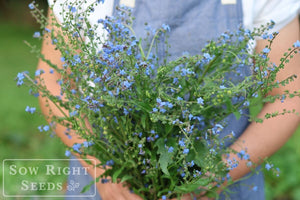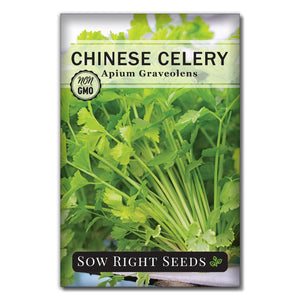How to Grow Celery from Seed for Sweeter, Crunchier Stalks
CeleryIn the Victorian era, having celery on your table was a sign of prosperity. Special vases were designed to display this delicious but rare vegetable.
Eventually, varieties and methods were developed that made celery easier to grow, and everyone could enjoy its uniqueness.
Now that celery is easy to find in the grocery store, it’s no longer displayed in special vases. However, even as a humble part of a crudités platter, celery is still a unique, healthy vegetable worthy of praise.

How to Grow Celery
Celery was first grown for its medicinal properties. But once varieties were developed that were less bitter, celery soon found its way into everyday eating.
Celery is an excellent source of vitamins A, C, K, and B6. It is high in fiber, potassium, and folate. It even has calcium, iron, and phosphorus and can neutralize acidic foods. Its low glycemic index makes it a healthy part of your diet.
However, this healthy vegetable is listed on the dirty dozen for having lots of pesticide residue. So maybe it’s time to start growing your own celery.

When to Plant Celery
Knowing when to plant celery is critical to growing a successful harvest. Celery thrives in cooler temperatures and can take anywhere from 90 to 120 days to reach maturity. Chinese celery takes about 90 days from transplanting.
Temperatures below 50º F and above 70º F can cause celery to bolt. This means it will stop growing stalks and start growing flowers and going to seed. Unfortunately, at this point, the celery can also turn bitter.
With this temperature range in mind, spring planting works well in some growing zones, but in others, fall planting will give you a better chance of successfully growing celery. For example, in zones 9 and 10, you will want to plant celery in the fall or winter.
Tips for Successful Celery Seed Germination
Whether you grow celery in the spring or fall, starting celery seeds indoors can improve germination rates.
- Start celery seeds indoors 8 to 10 weeks before the last spring frost.
- Chinese celery can be started 2 to 4 weeks before planting outdoors.
- Soak seeds overnight before planting for better germination.
- Celery seeds are tiny! This makes it hard to space out the seeds when planting. One helpful tip is to get the end of a toothpick wet. Then, touch it to one celery seed at a time to plant.
- Space the seeds 2 inches apart.
- Soil temperature can also speed up germination. For Utah Celery, the soil temperature should be 65º to 75ºF. The optimal soil temperature for Chinese celery is lower, at 50º to 60º F.
- Keep seeds moist until they sprout. Using a humidity dome will help ensure that they don’t dry out.
- Use grow lights to provide the necessary light for them to germinate.
Celery seeds will typically germinate in 14 to 21 days.

Transplanting Celery Plants
Celery seedlings should be about 4 inches tall and have 5 to 6 leaves before being transplanted.
You can transplant celery outdoors 2 to 3 weeks before the last frost if temperatures exceed 30º F. More mature plants have a better tolerance for cold weather. Young seedlings can be damaged or die when temperatures drop lower than 30º. Using covers can protect celery from frost damage.
Plant seedlings 6 to 10 inches apart.

Watering Celery
With a water content of 95%, it’s not surprising that celery needs lots of water to grow. The thick roots only go down to around 3 inches, but they spread out. A consistent watering schedule that keeps the soil moist but not too damp will give celery the best flavor and make it less stringy. This may be 2 to 3 inches of water per week in dry climates. Using mulch will help conserve soil moisture.

Where to Grow Celery
Choose a sunny but cool location to grow celery. It can tolerate light shade but needs a half day of full sun. A spot where celery plants can get morning sun and afternoon shade works well as long as it gets 5 to 7 hours of sunlight.
The amount of shade and heat can affect flavor. Gardeners notice that celery is more bitter when grown in really hot summers.
You can plant celery in a location where legumes grew the previous year, but avoid planting with pumpkins, squash, and cucumbers.
Good companion plants for celery are lettuce, spinach, and garden peas.
Celery roots grow 2 to 3 inches deep and spread wide. So ensure you have soil that holds moisture but drains well. A rich, fertile soil with lots of organic material is ideal.
Celery can also be grown in containers. Even though they have shallow roots, they do need room to spread, so pots as least 8 inches wide are recommended.

Fertilizing Celery
Celery is a heavy feeder and has higher potassium needs. Calcium is also an essential nutrient for celery growth. Additional fertilizer can be applied during the growing season.

Harvesting Celery
Homegrown celery is more flavorful than what you’ll find in the grocery store. And without any pesticide residue.
Celery stalks will be about 12 inches high when they are ready for harvesting. Harvest before it starts to flower.
With both Chinese celery and Utah celery, you can harvest individual stalks or wait for the entire head to mature. Taking outside stalks as needed will allow the celery to continue growing new stalks.
To harvest the whole plant at once, pull it from the ground and cut off the roots. This option will be necessary when the summer heat is too hot for celery to keep growing. It is also the best way to harvest it before the first freeze in the fall.
Store celery in the fridge to keep it crisp.
Fresh celery is delicious and can be eaten raw. However, Chinese celery is smaller but more flavorful. Therefore, it is usually added to cooked dishes rather than eaten raw.
You can use celery in all sorts of ways. Raw celery is a refreshing and healthy ingredient added to juices and smoothies. Celery is also an important flavor base with onions and carrots, and is simmered in soups and stews.
Another fun and delicious way to eat celery is to add a layer of peanut butter and top it with raisins or chocolate chips for “Ants on a Log.”
Any way you eat it, celery is a delicious, healthy vegetable.
Getting seeds started and knowing when and where to plant celery will help you have a successful harvest. And who knows, you might want a Victorian celery vase to proudly display your beautiful and delicious homegrown celery!
Written by Beverly Laudie








Leave a comment